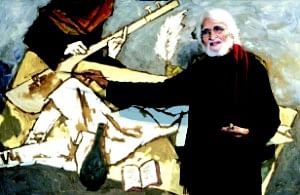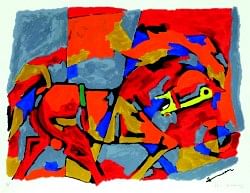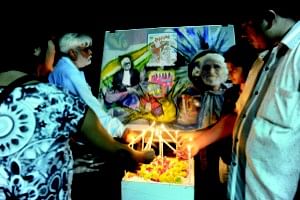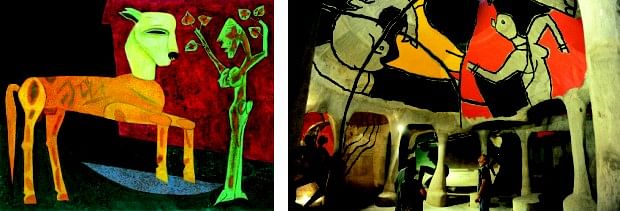| Home - Back Issues - The Team - Contact Us |
 |
| Volume 10 |Issue 23 | June 17, 2011 | |
|
|
Tribute Maqbool Fida Husain … Syed Badrul Ahsan
Maqbool Fida Husain's lonely passage to death in London earlier this month was once more a reminder of the predicament art has consistently lived through. Husain was ninety five at the time of his corporeal end. It was a phase in life he ought to have been allowed to live in dignity in his native India. And yet it was as a Qatari that he spent the last five years of what otherwise had been a magnificent existence. He was India's Picasso, as many would say, sadly content in his final years sketching royalty in his adopted country. In the summer, it was to London that he journeyed. As he waited in the London spring this time to see summer return in all its glory, the life went quietly out of him.
Husain was the iconoclastic painter, in Shabana Azmi's profound tribute. But then, there was the unconventional that took over his persona in nearly everything that he did. That, you might note, is the hallmark of an artist to whom existence is not merely a matter of what there is but, more poignantly, of what there might be and could have been. Small wonder, then, that it becomes easier for us to understand Husain's charming obsession with Madhuri Dixit, the muse around whom his swift brush strokes created poetry in all its lyrical affluence. Art creates, before it recreates. For Maqbool Fida Husain, therefore, there was that inextricable link between faith and the world of the imagination he sought to exploit in his modernistic depiction of the Hindu pantheon. Gods and goddesses, for him, were certainly an epitome of the divine. And yet art held out the huge possibility of infusing this divinity with all the attributes of corporeal human entities. The erotic, in Husain's scheme of things, came with a dash of poetry and on the wings of faith. His conviction infuriated his detractors. Yet he could do no less than reveal the sexuality inherent in the images of the gods and goddesses, each to each. The seduction of the flesh is undeniable. And desire is always electrifying.
In Fida Husain subsisted a larger than life soul. Banalities did not touch him. The mundane he kept at a respectable distance. He owned no studio, for every spot of earth where the artistic imagination seized hold of him swiftly, as it were, became his studio. He could be spotted sitting on the floor, or spread-eagled across it, sketching away with nary a thought to the world passing him by. At home in India and then all around the globe, he kept his feet on the ground, literally. Perhaps there was something of the metaphysical that came of his barefoot communion with the earth and the intellectual explosions of his artistic grandeur? That grandeur was part of the life force in him was always in plenteous evidence: he won the Padma Bhushan and the Padma Vibushan. Loftiness of character raised him to heights that others could only dream of scaling. A serious observer of life and all its tenuous realities, he was nevertheless endlessly aware of the need for aesthetics to come into an embellishment of it. The result was Meenaxi: A Tale of Three Cities and Gaja Gamini. In the fragrant Madhuri and in the tropically sultry Tabu, he ran his finger on the huge swathes of essential human character complementing their visions of art and life, together with a plenitude of feminine grace that he morally was driven to portray in his movies. Not many were enthused by the movies. The general run of men and women has never, historically, been inclined to contemplation of human behaviour emanating from a profundity of grey matter. Fida Husain understood and indeed acknowledged this truth. But what mystified him was the sinister work of the rabble. Hindu mobs bayed for his blood over his perceived humiliation of divinity. Muslim clerics, missing the point made by art, thought he was putting the knife into the faith he was born into. Fanaticism was rampant. It is fair to assume, then, that Husain must have looked back, to dwell long and hard on the cultural blasphemy the Taliban committed through blowing the Bamian statues in Afghanistan into rubble in the late 1990s. Bigotry is a molestation of faith. It is unwilling and unable to spot the transcendental taking shape in a marriage of art and religion. For Fida Husain, for courageous masters like him, devastating kristallnachts have regularly hounded the purveyors of art the world over.
Bitterness had no place in Maqbool Fida Husain's life and yet it irritated him to no end when the asinine got the better of wisdom among those determined to have his head on a platter. That no one in political authority came to his defence dismayed him. That the India he had loved all his life sensed not at all the heartbreak it caused in him through compelling him to renounce his citizenship is a living shame. In death, Maqbool Fida Husain casts a long, and lengthening, shadow over the small world of those who let the bloodhounds loose after him. For everyone else, his dying is as sudden as an unforeseen coming of blustery winter.
Copyright
(R) thedailystar.net 2011 |
||||||||||



